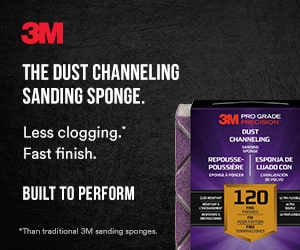 Jason Lunn is a Senior Application Engineer for 3M who provides training and education on a variety of the company’s products including safety, wall repair and abrasives.
Jason Lunn is a Senior Application Engineer for 3M who provides training and education on a variety of the company’s products including safety, wall repair and abrasives.
Q: What are some mistakes people make when sanding cabinets?
A: Sanding down cabinets to recoat them requires a lot of attention to detail. Choosing the right sanding products and appropriate grits are only the start. As you sand, you begin to learn more about the coatings, wood or veneer you’re dealing with, and adjustments undoubtedly need to be made.
Here’s a look at some common mistakes—and helpful tips to avoid them.
#1: Not cleaning cabinets before starting: Some people jump into sanding too quickly or assume the sanding will do the cleaning for them. Not true. Through years of hands touching cabinet doors, oils collect and build up on surfaces. In the kitchen, years of cooking can cause grease and food residue to build up on the cabinets as well. And if someone is an avid user of hairspray, that can build up a layer of grime on bathroom cabinets. To take the burden off the sandpaper to remove the buildup, use a TSP degreaser or other cleaning agent before you start sanding.
#2: Not knowing if you’re working with a veneer or solid wood: Sometimes it’s tough to determine which surface type you’re working with. If it’s veneer and you guess incorrectly, you run the risk of sanding too aggressively and ruining it. A quick way to tell if it’s veneer is to see if the grain on a flat surface matches up with the grain on the edge. If it does not, it is probably veneer. You can also look at a corner of the cabinet to see if the edge of the veneer is visible.
#3: Being overly aggressive with grit: Before sanding, there are a few factors to take into account such as the type of existing coating, its thickness, and how easy it will be to remove. Be careful not to be too aggressive with the grit until you know what you’re working with or you’ll likely create plenty of scratches to the wood underneath. Start with a less-coarse grit and only go coarser if needed. Or, start in an inconspicuous location to learn how the product will perform.
#4: Not sanding inner corners well enough: Getting in the corners or making sure crevices are sanded can be tedious work, but leaving paint or stain behind in these areas can create dark spots or adhesion issues. So, don’t just scuff and go … take your time and make sure you remove all the prior coatings. A power detail sander or angled sanding sponge works well for this. However, for beveled or curved edges—or ones with lots of detail—a dust-channeling sanding sponge can conform to those contours and allow you to sand them efficiently.
#5: Not understanding the true grit of a sanding sponge: Sometimes, even pros have a hard time gauging the true grit of the sponge surface because of a sponge’s soft interior. Be aware that when pushing down, the grit pushes into the sponge, so the grit of a sanding sponge tends to be a little higher than what’s indicated on the package.
#6: Not sanding between coats: Most people are good about allowing for appropriate dry time between coats, but many do not sand between coats. Use a fine-grit sandpaper to smooth out imperfections or uneven spots on early coats so that the final coat is smooth and adheres better.
#7: Not removing dust between coats: When sanding between coats, the last thing you want is to ruin the finish by getting dust in the fresh coat of paint or poly. That’s why it’s critical to remove the sanding dust completely by vacuuming and using a tack cloth.
Ultimately, being patient and not rushing are the two primary ways to get the great results you’re seeking.




